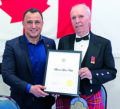General News » News
Web-based “community” solution proposed for traffic woes
January 18, 2017 · 0 Comments
By Brock Weir
Traffic issues in just about every corner of Aurora dominated a significant chunk of Council’s time over the course of 2016, but 2017 could bring a new and “innovative” solution to these local age-old issues.
Next week, Council is set to consider a new proposal on addressing traffic issues through an overhauled Traffic Safety Advisory Committee coupled with “web-based community engagement.”
Last Spring, Council voted to re-institute Aurora’s defunct Traffic Safety Advisory Committee as a way to address mounting traffic concerns – and proposed solutions – ranging from on-street parking, to traffic flow, to speed bumps. A rebooted Advisory Committee has been long-championed by Councillor Sandra Humfryes and started to gain traction around the Council table in the last few months.
The new model proposed by staff, however, is radically different from the old standard addressing what they say is the “weakest link” when it comes to traffic complaints and solutions: community engagement.
“The previous Traffic Safety Advisory Committee (TSAC) model was a reactive model and fully complaint driven,” according to a joint report by Ilmar Simanovskis, Aurora’s Director of Infrastructure, and Stephanie Mackenzie-Smith, Manager of Corporate Communications, who joined the Town last year. “Staff propose moving to a more proactive and solutions-oriented approach. Communications that could not be effectively resolved through the TSAC Committee often were introduced at Council creating challenges in the process.
“Communications staff has identified an innovative approach to community engagement that utilizes an online platform to identify issues, generate solutions, share information, and create consensus. Utilizing a platform called PlaceSpeak, residents can verify their location and, using a geographic-based interface, drop pins on the map to identify areas of concern [such as a stop sign needed at a particular location]. Other residents can then add their comments of support, disagreement or add ideas to create solutions to the problem. The platform will allow staff to respond to questions, share reports and best practices, Council reports and other resources.”
Polls can also be put in place to measure the level of concern over issues raised and support for possible solutions.
This web-based interactive tool from PlaceSpeak, which comes at a cost of up to $26,000, will be a “first of its kind” in the municipal sector, they note, but its success depends on community engagement. If it does indeed prove to be successful, the report notes this could become a norm on planning and development issues, public notices, and other areas of public concern.
“Traditional approaches to community engagement around traffic issues present some challenges,” say Ms. Mackenzie-Smith and Mr. Simanovskis. “Solutions, frequently driven by a single or small cluster of complaints, can sometimes lead to costly implementations that occasionally cause other unforeseen traffic issues and dissatisfaction with residents who were not engaged in the decision-making process. Often, residents have the answers to traffic problems as they know their communities best. They witness the daily traffic flows and challenges presented by existing infrastructure and traffic management strategies.
“[This tool] offers the opportunity for the community to take a proactive approach to traffic safety and provides an alternative to the reactive approach traditional models offer. Residents will have the opportunity to quickly and easily add their voice to the consultation process and ensure that their voices are heard by others in the community and by decision-makers. By making it easier for more people to add their comments, there is a reduced risk of making decisions based on a small but vocal minority. In addition, even if the ultimate outcome is not what a resident wants, they may be more likely to feel that the process was fair.”
Over the course of the last year, many traffic situations cropped up at Council – both mentioned at the table by Council members themselves or raised at the podium by residents at large – including a since-fizzled proposal from Mayor Geoff Dawe to limit traffic on Yonge Street to one lane in each direction to allow for further on-street parking, proposals from Councillor Tom Mrakas for one-way streets in the Town’s historic southeast quadrant, resident-driven speed cushions installed on four busy streets, and the restriction of parking in the downtown core to combat GO commuters.
The latter had the unintended consequences of wreaking havoc on an area medical centre, which left some Councillors criticizing the process for being quick to react and not fully considerate of its full impact.
Should Council members approve the proposal at the Committee level on January 24 and ratify their decision the following Tuesday, a soft roll-out of the web-based “Traffic and Pedestrian Solution” could begin as early as February with public open houses to formally present the app – and how it might have been used up to that point – set for April. A formal launch period is eyed for May to December.











